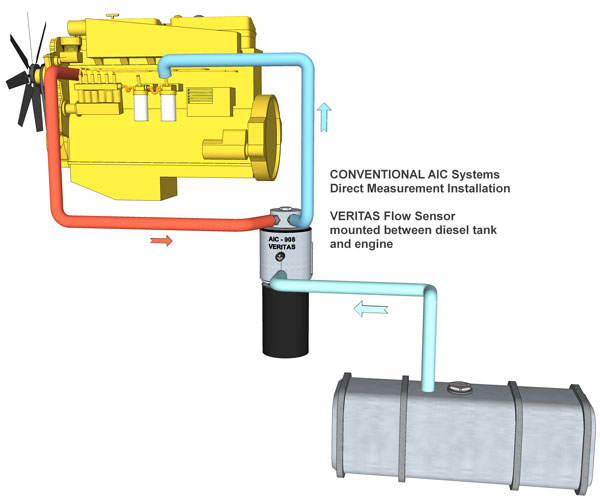
Direct measurement : simple and accurate
In the engine fuel consumption measurement world, two principles are competing, each with its benefits and inconveniences :
- AIC Direct Measurement principle
- The Differential Measurement principle
More than 40 years ago, AIC, as a pioneer in its field, revolutionised the fuel measuring discipline by introducing the Direct Measurement principle, which is AIC’s technology.
With the Direct Measurement principle, the installation of only one AIC Fuel Flowmeter is required. The fresh and cool fuel consumed is aspirated from the tank and its volume measured by the AIC fuel Flowmeter before arriving in the AIC vortex head. In the Vortex head, the fresh fuel from the tank is mixed with the fuel returning from the engine. From the AIC Vortex head, the fuel is pumped to the engine by the fuel pump. With this solution no fuel is going back to the tank and the fuel passing through the AIC Volumetric measuring chamber represents precisely the real engine consumption. The great benefit is that an AIC fuel consumption measuring system is ready to use right after installation.
Differential measurement is the less accurate way to measure fuel
The second solution for measuring fuel consumption is the “Differential Measurement”. This system consists in measuring the quantity of fuel going to the engine and subtract from it what returns to the tank. Such solution necessitates the installation of two flowmeters. One for measuring the fuel flow going from the tank to the engine and a second one for measuring the fuel flow returning from the engine to the tank. When passing through the engine the fuel warms up and changes in volume. This physical modification requires the use of a compensation factor in the calculation algorithm of the consumption. As a consequence, the engine consumption obtained with Differential Measurement is the result of a calculation which accuracy and reliability greatly depend of the compensation factor used.
With AIC Systems Direct Measurement principle, the fuel flow measured by the flow Sensor represents exactly the volume of fuel burned by the engine. No calculation and compensation factor are used, thus providing reliable values.

